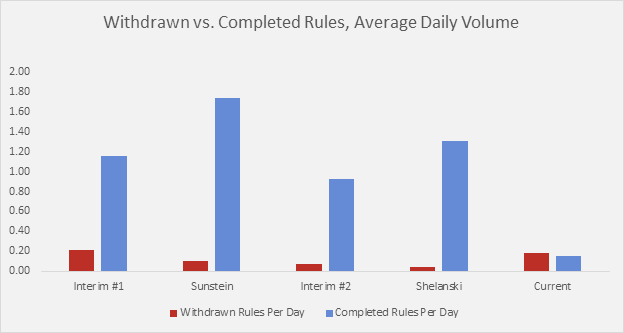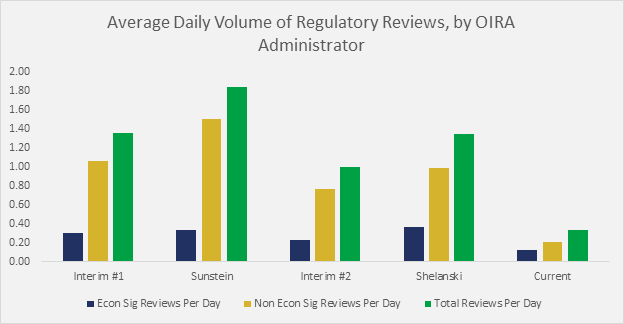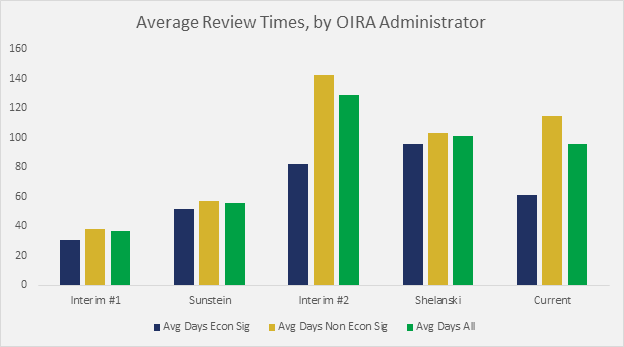Insight
July 10, 2017
Professor Neomi Rao is Now the “Reg Czar”
Today, the Senate formally voted to approve the nomination of George Mason Law School Professor Neomi Rao to be the next Administrator of the Office of Information and Regulatory Affairs (OIRA), colloquially known as the “Reg Czar.” After an 11-4 vote in committee, with Democrats Claire McCaskill, Tom Carper, and Heidi Heitkamp voting to report the nomination favorably, Professor Rao enjoyed a healthy degree of bipartisan support.
With Professor Rao taking the helm, what can the nation expect now that there is a central figure running regulatory policy? If history is any guide, slightly more regulatory activity, although under the Trump Administration, this might be of the deregulatory flavor. According to American Action Forum (AAF) research, when OIRA is without an administrator, or reg czar, regulatory output declines slightly.
For instance, from October 2009 (the first full month of OIRA Administrator Cass Sunstein’s tenure) to August 2012 (the last month of his tenure), the federal government published an average of 308 rulemakings per month, including an average of 34 significant rules. During this time, OIRA approved an average of 54 rulemakings per month, including 9.5 economically significant rules. However, when there was no OIRA Administrator under President Obama, the total number of rulemakings per month fell from 308 to 283; the number of significant rules fell from 34 to 23. For OIRA reviews, the pace declined from 54 to 29 rulemakings a month and the economically significant output fell from 9.5 to seven. The graph below displays the average daily volume of completed and withdrawn rulemakings in recent years, indicating periods without an administrator produce lower output:
Although this evidence doesn’t prove that the lack of an OIRA Administrator causes a decrease in regulatory output, it is suggestive. When Administrator Howard Shelanski assumed control at OIRA, these trends persisted. Overall regulatory output rose from 283 without an administrator to 300 under Administrator Shelanski’s tenure (excluding the midnight period); significant output increased from 23 without a reg czar to 27 under Administrator Shelanski. At OIRA, these trends were more pronounced: the 29 rulemakings-per-month increased to 37 and the number of economically significant reviews from seven to 10.3.
The chart below tracks average daily volume by OIRA Administrator, including the interim periods:
Average Review Times
Under President Trump, without an OIRA Administrator, the average review time is 96 days, with 61 days for economically significant actions, and 115 days for other rulemakings. However, those figures are skewed heavily by the paucity of overall regulatory volume and the number of withdrawn rulemakings (essentially the legacy rulemakings from the Obama Administration that were discarded in 2017). When examining only approved rulemakings, the average review time under the Trump Administration is a scant 23 days.
This contrasts with the average rulemaking lifetimes during the Obama Administration. For example, under Administrator Cass Sunstein, the average review time for all rulemakings was 56 days, with an economically significant average of 52. During the interim, with no OIRA Administrator, the average review time jumped to 129 days for all regulations and to 82 days for economically significant measures. Administrator Shelanski pledged to reduce review times, and did so for all rulemakings. The average fell from 129 to 101, but the economically significant average crept up from 82 to 96. However, the mere approval of long-stalled rules can drive up the mean review time.
The graph below charts average review times during these periods.
Predicting the Future
It’s unclear whether the Trump Administration’s brisk pace at OIRA will persist when Administrator Rao assumes office. During the interim under President Obama, the average review times skyrocketed. Yet, there are currently only 28 rulemakings under review at OIRA, with six economically significant measures, and the Trump Administration has been historically slow approving new measures, so there isn’t a glut of regulation in the queue.
What is somewhat clear from the data, is that when an OIRA Administrator is in place, regulatory output increases. Under the Trump Administration, with a newly confirmed administrator, can we expect more regulation? Given the regulatory posture and historic output of this administration, there might be more rules leaving OIRA, but they might be stays of existing rules and deregulatory actions. In other words, we might expect the cost-cutting totals of the Trump Administration to increase now that Professor Rao has become Administrator Rao.
The reg czar doesn’t draft new regulatory or deregulatory actions. Administrator Rao and OIRA will review these rules, and to some extent, control the volume of new rules. Much of the work depends on the deregulatory actions of agencies. When the administration releases the updated Unified Agenda, the public will get its first clue how busy, or bored, OIRA will be in the coming months.
Conclusion
Given the trends discussed, the nation can perhaps expect an increase in rulemaking volume, and to be more specific, an increase in deregulatory actions. Currently, there is a major review of the “Clean Power Plan,” a rescission of the 2015 Interior fracking rule, a stay of the solid waste landfill rules, and a revision of the “Waters of United States” rule. Combined, these measures could reduce regulatory costs by more than $10 billion. Whether they proceed on time, significantly changed, or at all, is largely dependent on Administrator Rao and the work of OIRA.













